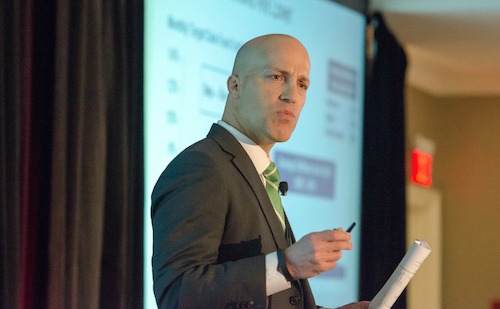
While Canadians rely on individual savings more than they have in the past due to the decline in defined benefit pension plans, they’re susceptible to behavioural reactions during market downturns.
Chris Moeder, senior research analyst in the global asset allocation group at Fidelity Investments, used his presentation during the 2016 DC Plan Summit to highlight how target-date funds present an opportunity to maximize outcomes for plan members because they mitigate reactionary decisions by participants.
Moeder noted the pitfalls that arise when the market becomes choppy and people take their money out for five or 10 years. “That five-year or 10-year gap when they’re not in the market, that is very likely at a time in which they have a very high balance because people tend to panic more as they get older,” he said.
Video: The advantages of a ‘through’ approach
Moeder outlined how investors can take advantage of the fact that those in target-date funds panic less. He noted there are two different ways to handle asset allocation. Under what he called a “to” approach, an investor gets to the minimum allocation of equity right when someone approaches retirement. The idea is to protect members from market risk and mitigate the probability that they’ll abandon assets.
However, because members in target-date funds have lower outflows, Moeder pointed to the advantages of what he called a “through” approach with a higher allocation to equity as someone hits retirement but then continues to go down. That approach balances market risk and the investment challenge of getting a real return of at least four per cent. “People need return and this is a way in which to get them there,” said Moeder.
When looking historically, Moeder compared the two approaches and found that “through” investors are at an advantage. In the typical scenario with a $50,000 salary, those with a “through” approach have approximately $69,000 more in savings at age 65.
Moeder concluded that a “through” approach could leverage target-date investor behaviour to generate better outcomes. “Via prudent risk taking, we can help them become better off,” he said.
